I find it interesting that modern East Asian men are particularly fond of Indian films featuring beautiful women from the Indian subcontinent!
I wonder if Hassan likes films made in the Indian subcontinent! I enjoy Indian films because of the allure of Indian actresses!😄
Pakistani and Bangladeshi films are not very popular in East Asia!
 Samrat Prithviraj
Samrat Prithviraj
Samrat Prithviraj (transl. Emperor Prithviraj) is a 2022 Indian Hindi-language epic historical action drama film written and directed by Chandraprakash Dwivedi and produced by Aditya Chopra under Yash Raj Films. The film is based on Prithviraj Raso, a Braj language epic poem about the life of Prithviraj Chauhan, a king from the Chahamana dynasty.[14] It features Akshay Kumar as the titular character, while Manushi Chhillar makes her Hindi film debut by playing the role of Sanyogita. The film also stars Sanjay Dutt, Sonu Sood, Manav Vij, Ashutosh Rana and Sakshi Tanwar in other pivotal roles.
An official motion poster for the film was released by Yash Raj Films on 9 September 2019, revealing its release in cinemas on Diwali 2020.[15] Principal photography began in Jaipur on 15 November 2019, but was suspended in March 2020 owing to the COVID-19 pandemic in India, due to which the film was indefinitely postponed. The film's shoot resumed in October 2020 at YRF Studios. Originally titled Prithviraj, the film was renamed Samrat Prithviraj following a court litigation week ahead of its scheduled release.[16] The film was released on 3 June 2022.
The film received mixed-to-negative reviews from critics. It was made on a reported budget between ₹150 crore (US$18 million) and ₹300 crore (US$35 million),[12] and amassed a worldwide gross collection of ₹90.32 crore (US$11 million),[13] making it a box office failure.[17][18]
Samrat Prithviraj may not have been a box office hit globally, but he was a huge hit with East Asians!
Because this movie depicts the ongoing war between Islam and Hinduism in the Indian subcontinent!
Manushi Chhillar
's charm and performance in this film did not catch on with East Asians, and instead, the performances of male actors were more popular!
 Padmaavat
Padmaavat
Padmaavat is a 2018 Indian Hindi-language epic historical drama film directed by Sanjay Leela Bhansali. Based on the epic poem of the same name by Malik Muhammad Jayasi, it stars Deepika Padukone as Rani Padmavati, a Sinhalese-born Rajput queen known for her beauty, wife of Maharawal Ratan Singh, played by Shahid Kapoor. Sultan Alauddin Khilji, played by Ranveer Singh, hears of her beauty and attacks her kingdom to enslave her. Aditi Rao Hydari, Jim Sarbh, Raza Murad, and Anupriya Goenka are featured in supporting roles.[1][8]
With a production budget of ₹180 crore (US$26.32 million)–₹190 crore (US$27.78 million), Padmaavat is one of the most expensive Indian films ever made.[4][5][6] Initially scheduled for release on 1 December 2017, the film faced numerous controversies. Amid violent protests, its release was indefinitely delayed. The Central Board of Film Certification later approved the film with few changes, which includes the addition of multiple disclaimers and a change from its original title Padmavati.[9][10] It was rescheduled for release on 25 January 2018 in 2D, 3D and IMAX 3D formats, making it the first Indian film to be released in IMAX 3D.[11]
Upon release, Padmaavat received mixed-to-positive reviews from critics, with praise for the visuals, costume design, cinematography, screenplay, soundtrack, and performances, but criticism for its pacing, runtime, and adherence to regressive patriarchal mores.[12] Critics also disliked the portrayal of Khilji as a stereotypical evil Muslim king and Ratan Singh as the righteous Hindu king, which led to protests by the respective religious communities.[13][14][15][16][17][18][19] Despite not being released in some states of India, it grossed over ₹571.98 crore (US$68 million) at the box office, becoming a major commercial success and the third highest-grossing Indian film of 2018.[20][21]
At the 64th Filmfare Awards, Padmaavat received a leading 18 nominations, including Best Film, Best Director (both for Bhansali), Best Actress (Padukone) and Best Actor (Singh), and won 4, including Best Actor (Critics) (Singh) and Best Music Director (Bhansali).[22] It also won 3 National Film Awards, including Best Music Direction (Bhansali).[23]
East Asian men have been praising Deepika Padukone 's acting skills and charm!
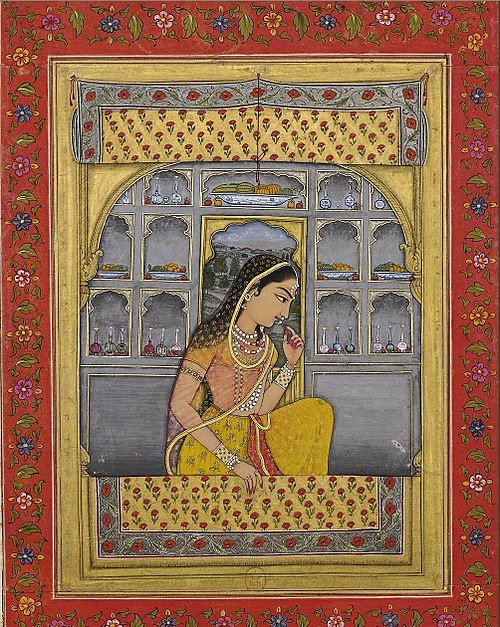 Rani Padmini
Rani Padmini
Padmini, also known as Padmavati or Rani Padmavati, was a 13th–14th century queen of the Kingdom of Mewar in India.[2] Several medieval texts mention her, although these versions are disparate and many modern historians question their overall authenticity.[3]
The Jayasi text describes her story as follows: Padmavati was an exceptionally beautiful princess of the Sinhalese kingdom (in Sri Lanka).[a] Ratan Sen, the Rajput ruler of Chittor Fort, heard about her beauty from a talking parrot named Hiraman. After an adventurous quest, he won her hand in marriage and brought her to Chittor. Ratan Sen was captured and imprisoned by Alauddin Khalji, the Sultan of Delhi. While Ratan Sen was in prison, the king of Kumbhalner Devapal became enamoured with Padmavati's beauty and proposed to marry her. Ratan Sen returned to Chittor and entered into a duel with Devapal, in which both died. Alauddin Khalji laid siege to Chittor to obtain Padmavati. Facing defeat against Khalji, before Chittor was captured, she and her companions committed Jauhar (self-immolation) thereby defeating Khalji's aim of obtaining her and safeguarding their honour. Coupled with the Jauhar, the Rajput men died fighting on the battlefield.
Many other written and oral tradition versions of her life exist in Hindu and Jain traditions. These versions differ from the Sufi poet Jayasi's version. For example, Rani Padmini's husband Ratan Sen dies fighting the siege of Alauddin Khalji, and thereafter she leads a jauhar. In these versions, she is characterised as a Hindu Rajput queen, who defended her honour against a Muslim invader. Over the years she came to be seen as a historical figure and appeared in several novels, plays, television serials and movies.
The legend of Padmavati has been famous in East Asia since long ago!
The Buddhist and Hindu legends of the Indian subcontinent remain famous in East Asia to this day!
1.The Creation Myth of the Indian Subcontinent as Seen by East Asians
The Indian woman who married the Chinese emperor?
Many East Asian scholars estimate that exchanges between Indo-Aryans and East Asians began in prehistoric times!
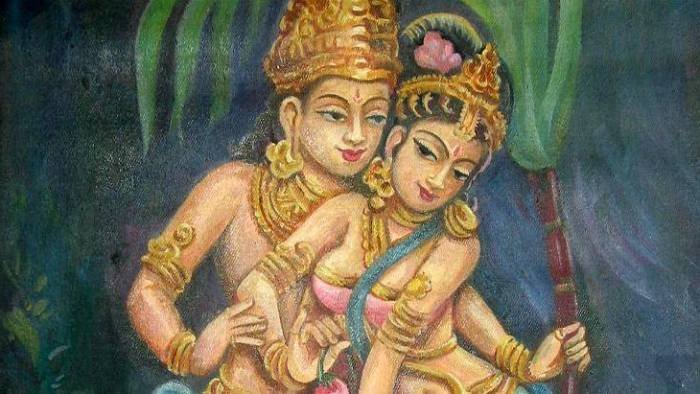
East Asians who visited the Indian subcontinent in ancient times spread stories about the beauty of Indian women.
In ancient Chinese historical records, it is said that women in the Indian subcontinent had white skin.
So, East Asian scholars have speculated that the Aryans who entered the Indian subcontinent 3,000 years ago originally had white skin.
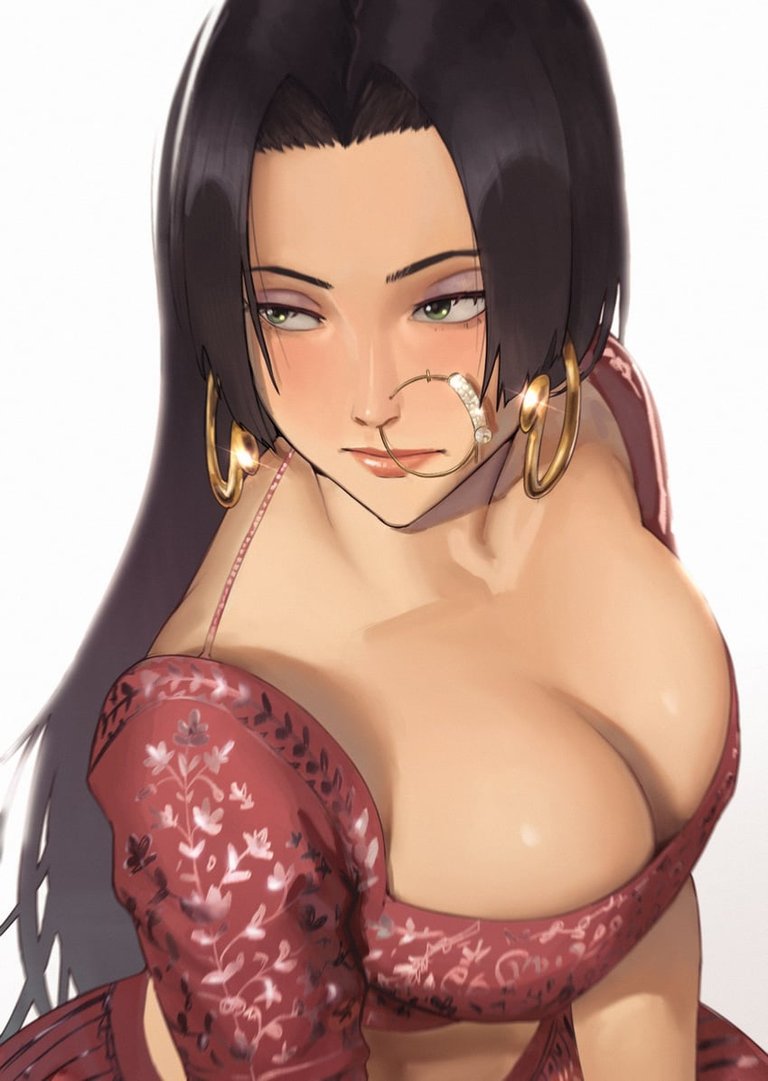

I assumed that the Aryans either darkened their skin tone in the tropical regions of the Indian subcontinent due to sunlight or mixed with Dravidians, resulting in a darker skin tone like Hassan's!
East Asian men were amazed by the variety of skin tones of women in the Indian subcontinent!
I assumed that the Aryans who entered the Indian subcontinent 3000 years ago had originally light skin!
I thought so because Hassan's appearance resembles Europeans!


East Asians who have traveled to the Indian subcontinent have said that Pakistanis have lighter skin and more blond hair!
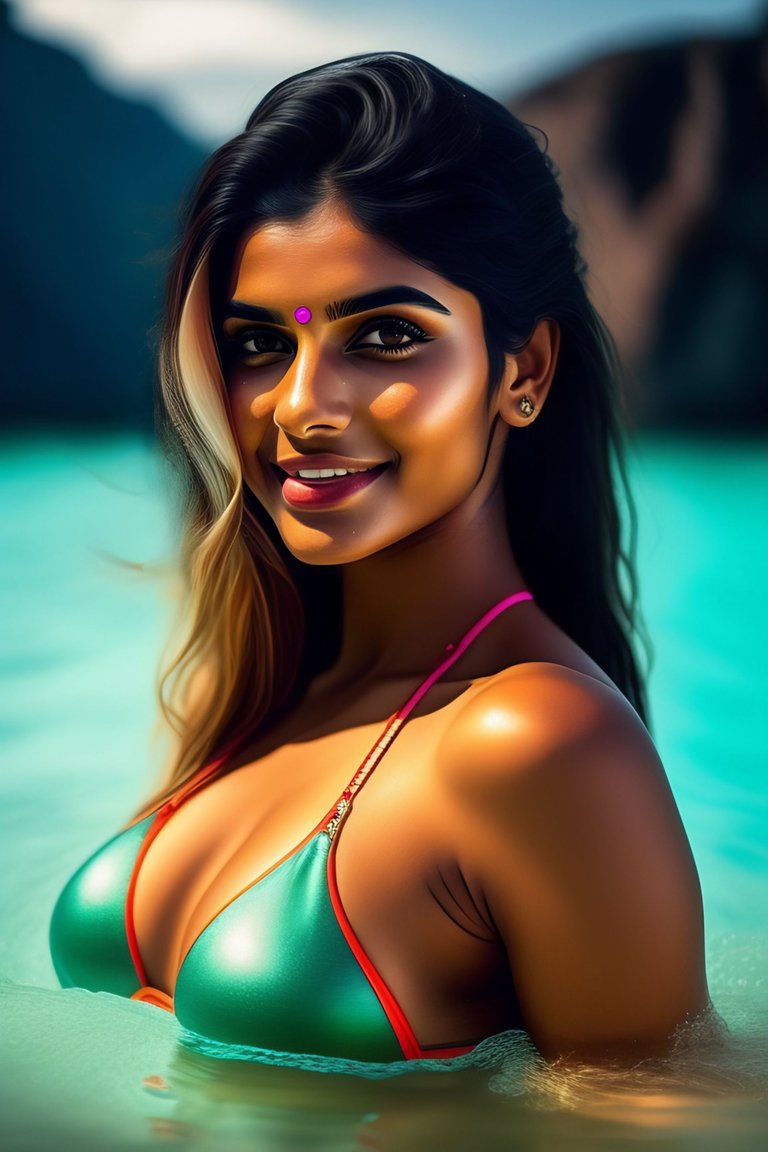

An East Asian man and a Bangladeshi woman
The skin color of people in Bangladesh and India appeared darker than that of Pakistan.
It's surprising how similar the Aryans of the Indian subcontinent look, yet their skin tones are so varied!
East Asians who traveled through the Indian subcontinent said that people with darker skin were friendlier and more docile.

So, East Asian men argued that women from the Indian subcontinent with darker skin tones were good marriage candidates.
 A commemorative Rs. 5.00 postage stamp on Queen Heo Hwang-ok was issued by India in 2019.
A commemorative Rs. 5.00 postage stamp on Queen Heo Hwang-ok was issued by India in 2019.
Heo Hwang-ok (Korean: 허황옥; Hanja: 許黃玉; 32–189AD) also known as Empress Boju (보주태후; 普州太后),[2] was a legendary queen mentioned in the Samguk yusa, a 13th-century Korean chronicle.
According to the Samguk yusa, she became the wife of King Suro of Geumgwan Gaya (part of the Kaya confederacy) at the age of 16, after having arrived by boat from a distant kingdom called "Ayuta (阿踰陁)"[3] with many theorizing it to be located in India, Thailand or Central Asia (i.e. Tibet).[4][5][6]
There is a tomb in Gimhae, South Korea, that is believed to be hers,[7] and a memorial in Ayodhya, India, built in 2020.[8]
Kings of ancient East Asia married women from the Indian subcontinent.
Heo Hwang-ok is a legendary figure who is said to have been a woman from the Indian subcontinent who married a Korean king.
I guessed that she was the first to spread Indian Buddhism to ancient Korea.
There is a legend that Korean kings who had Indian women as mothers were seven feet tall.
Indian women who married East Asian kings bore many large, strong children.
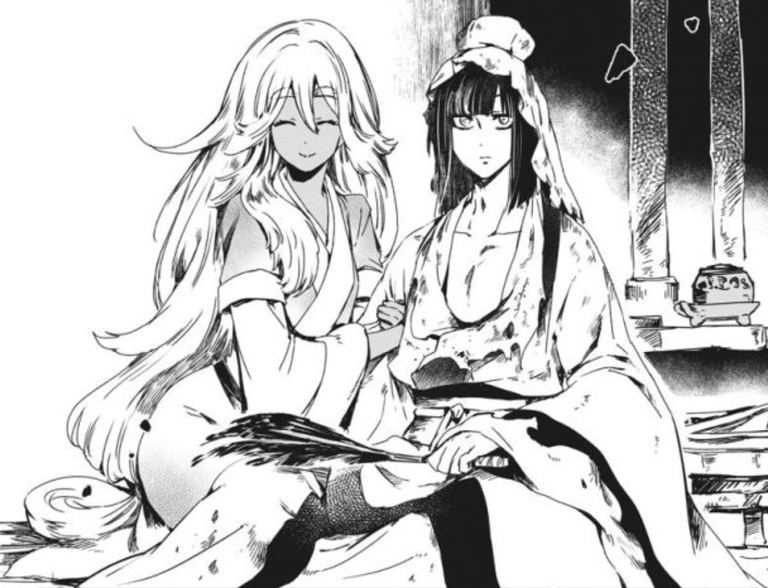
The Indian woman who married the Chinese king
So, East Asians considered women from the Indian subcontinent to be good marriage partners.
 Indo-Aryan migrations
Indo-Aryan migrations
The Indo-Aryan migrations[note 1] were the migrations into the Indian subcontinent of Indo-Aryan peoples, an ethnolinguistic group that spoke Indo-Aryan languages.[2] These are the predominant languages of today's Bangladesh, Maldives, Nepal, North India, Pakistan, and Sri Lanka.[3]
Modern East Asian scholars have found great fascination and sympathy with the Aryan theory created by Europeans.
I thought that the Aryan theory could explain why East Asians imported the civilization of the Indian subcontinent and achieved the birth and development of East Asian civilization!
Some modern East Asian scholars argue that Aryans and East Asians may have shared a common ancestor.
Is that why East Asians find women from the Indian subcontinent so friendly?

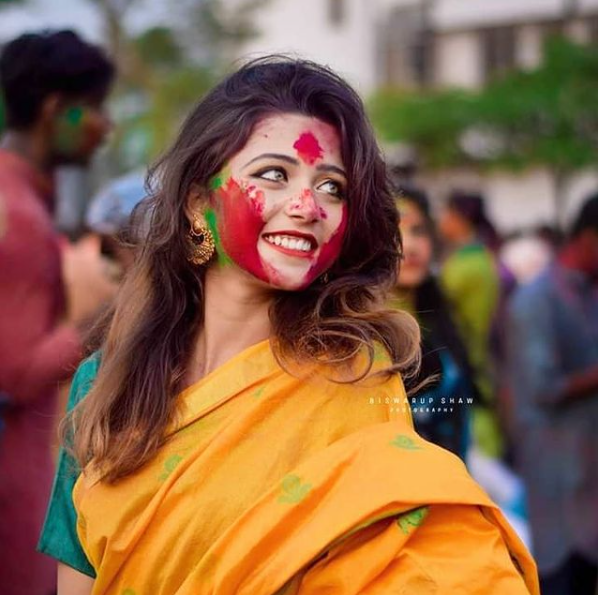
Many East Asian men wanted to marry the Indian woman in this photo.
From Hassan's perspective, how beautiful is she?😃


Since ancient times, the physical attractiveness of women from the Indian subcontinent has dominated East Asian men.
 Four Asiatic lions stand back to back on a circular abacus. The Buddhist wheel of the moral law appears in relief below each lion. Between the chakras appear four animals in profile—horse, bull, elephant, and lion. The architectural bell below the abacus, is a stylized upside-down lotus
Four Asiatic lions stand back to back on a circular abacus. The Buddhist wheel of the moral law appears in relief below each lion. Between the chakras appear four animals in profile—horse, bull, elephant, and lion. The architectural bell below the abacus, is a stylized upside-down lotus
The Lion Capital of Ashoka is the capital, or head, of a column erected by the Mauryan emperor Ashoka in Sarnath, India, c. 250 BCE. Its crowning features[1] are four life-sized lions set back to back on a drum-shaped abacus. The side of the abacus is adorned with wheels in relief, and interspersing them, four animals, a lion, an elephant, a bull, and a galloping horse follow each other from right to left. A bell-shaped lotus forms the lowest member of the capital, and the whole 2.1 metres (7 ft) tall, carved out of a single block of sandstone and highly polished, was secured to its monolithic column by a metal dowel. Erected after Ashoka's conversion to Buddhism, it commemorated the site of Gautama Buddha's first sermon some two centuries before.
Ashoka's lion statues remain famous among East Asian historians.
He spread Buddhism throughout Asia and had a profound influence on its emergence there.
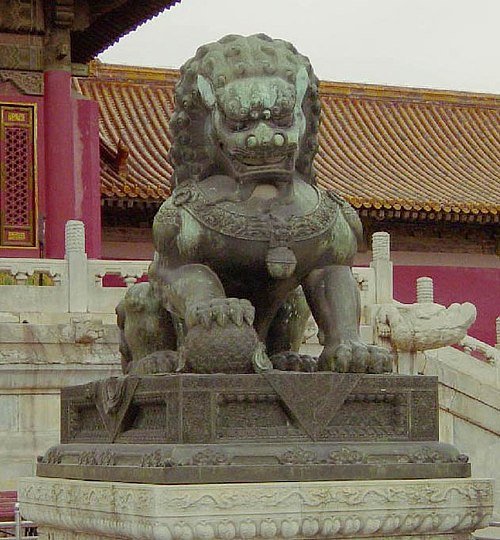 A Ming-era guardian lion in the Forbidden City
A Ming-era guardian lion in the Forbidden City
Chinese guardian lions, or imperial guardian lions, are a traditional Chinese architectural ornament. Typically made of stone, they are also known as stone lions or shishi (石獅; shíshī). They are known in colloquial English as lion dogs, foo dogs, or fu dogs. The concept, which originated and became popular in Chinese Buddhism, features a pair of Asiatic lions — often one male with a ball that represents the material elements and one female with a cub that represents the element of spirit — that were thought to protect the building from harmful spiritual influences and harmful people that might be a threat. Used in imperial Chinese palaces and tombs, the lions subsequently spread to other parts of Asia including Japan (see komainu), Korea, Mongolia, the Philippines, Tibet, Thailand, Myanmar, Vietnam, Sri Lanka, India, Nepal, Cambodia, Laos, Singapore, and Malaysia.
I have speculated that Ashoka's lion statues are the progenitors of Chinese guardian lions.
There are lions in the Indian subcontinent, but there are no lions in East Asia.
By the way, I thought that the fact that the lion was the symbol of royal authority in East Asia was evidence that Buddhism in India had a great influence on the birth of East Asian civilization!
This is especially evident in Korean legends, where I speculate that a Korean king married a woman from the Indian subcontinent!
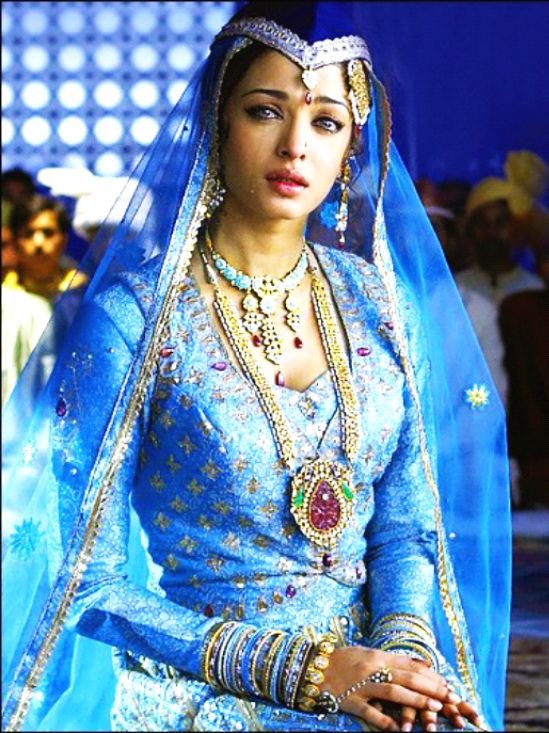
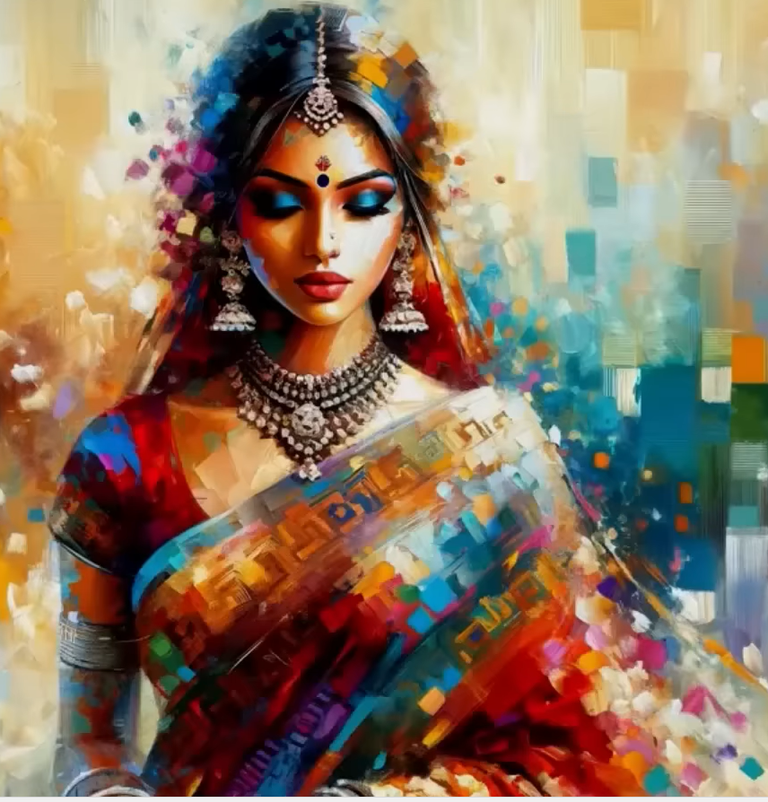
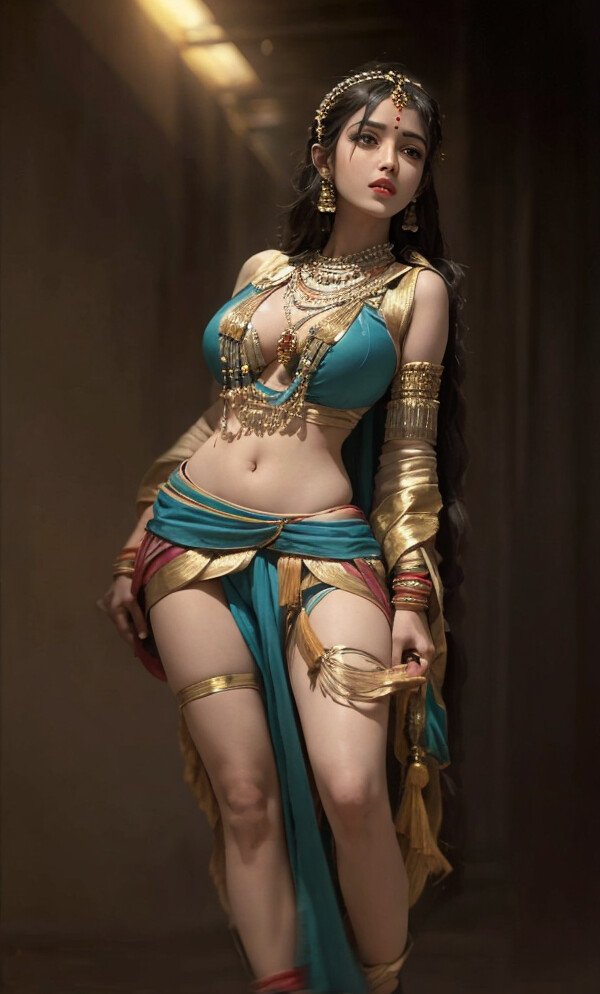

Could that be why East Asian men perceive women from the Indian subcontinent as the most beautiful in the world?
These paintings of beauties from the Indian subcontinent drawn by an East Asian man!
1. Why do East Asians read Genesis in the Bible?
Disclaimer: The above article is entirely the result of personal research, so there's a possibility of misunderstandings and errors!
I hope my friends understand my awkward English!

Congratulations @goldgrifin007! You have completed the following achievement on the Hive blockchain And have been rewarded with New badge(s)
Your next target is to reach 6500 comments.
You can view your badges on your board and compare yourself to others in the Ranking
If you no longer want to receive notifications, reply to this comment with the word
STOPDear @hivebuzz !
Thank you for surpport!
You're on a quest for greatness @goldgrifin007, and we have no doubt that you'll reach your new target soon!